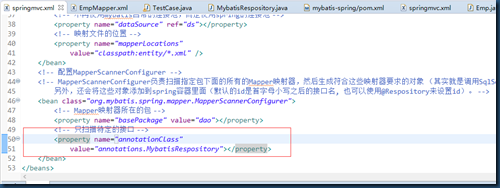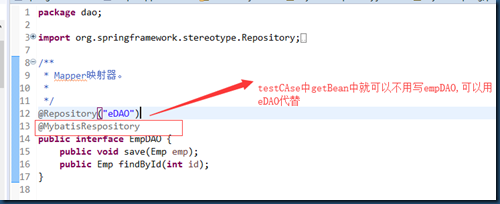spring集成mybatis
(1)编程步骤
1.导包。spring-webmvc,mybatis,mybatis-spring,spring-jdbc,dbcp,ojdbc.
2.配置文件 添加spring的配置文件。
注:mybatis的配置信息可以添加到spring的配置文件当中(只需要配置SqlSessionFactoryBean)。
3.实体类
4.映射文件
5.Mapper映射器。
6.在spring的配置文件中,添加MapperScannerConfigurer.
该bean负责调用SqlSession的getMapper方法,创建符合Mapper映射器要求的对象。
注:该bean会将这个对象添加到spring容器里面。
<?xml version="1.0" encoding="UTF-8"?> <beans xmlns="http://www.springframework.org/schema/beans" xmlns:xsi="http://www.w3.org/2001/XMLSchema-instance" xmlns:context="http://www.springframework.org/schema/context" xmlns:jdbc="http://www.springframework.org/schema/jdbc" xmlns:jee="http://www.springframework.org/schema/jee" xmlns:tx="http://www.springframework.org/schema/tx" xmlns:aop="http://www.springframework.org/schema/aop" xmlns:mvc="http://www.springframework.org/schema/mvc" xmlns:util="http://www.springframework.org/schema/util" xmlns:jpa="http://www.springframework.org/schema/data/jpa" xsi:schemaLocation=" http://www.springframework.org/schema/beans http://www.springframework.org/schema/beans/spring-beans-3.2.xsd http://www.springframework.org/schema/context http://www.springframework.org/schema/context/spring-context-3.2.xsd http://www.springframework.org/schema/jdbc http://www.springframework.org/schema/jdbc/spring-jdbc-3.2.xsd http://www.springframework.org/schema/jee http://www.springframework.org/schema/jee/spring-jee-3.2.xsd http://www.springframework.org/schema/tx http://www.springframework.org/schema/tx/spring-tx-3.2.xsd http://www.springframework.org/schema/data/jpa http://www.springframework.org/schema/data/jpa/spring-jpa-1.3.xsd http://www.springframework.org/schema/aop http://www.springframework.org/schema/aop/spring-aop-3.2.xsd http://www.springframework.org/schema/mvc http://www.springframework.org/schema/mvc/spring-mvc-3.2.xsd http://www.springframework.org/schema/util http://www.springframework.org/schema/util/spring-util-3.2.xsd"> <util:properties id="jdbc" location="classpath:db.properties" /> <!-- 配置连接池 --> <bean id="ds" class="org.apache.commons.dbcp.BasicDataSource" destroy-method="close"> <property name="driverClassName" value="#{jdbc.driverclass}" /> <property name="url" value="#{jdbc.url}" /> <property name="username" value="#{jdbc.user}" /> <property name="password" value="#{jdbc.password}" /> <property name="maxActive" value="#{jdbc.maxActive}" /> </bean> <!-- 配置SqlSessionFactoryBean --> <!-- spring集成mybatis,不再需要mybatis的配置文件,使用SqlSessionFactoryBean来代替mybatis的配置文件。 --> <bean id="ssfb" class="org.mybatis.spring.SqlSessionFactoryBean"> <!-- 不再使用mybatis自带的连接池,而是使用spring的连接池 --> <property name="dataSource" ref="ds"></property> <!-- 映射文件的位置 --> <property name="mapperLocations" value="classpath:entity/*.xml" /> </bean> <!-- 配置MapperScannerConfigurer --> <!-- MapperScannerConfigurer负责扫描指定包下面的所有的Mapper映射器,然后生成符合这些映射器要求的对象 (其实就是调用SqlSession的getMapper方法)。 另外,还会将这些对象添加到spring容器里面(默认的id是首字母小写之后的接口名, 也可以使用@Respository来设置id)。 --> <bean class="org.mybatis.spring.mapper.MapperScannerConfigurer"> <!-- Mapper映射器所在的包 --> <property name="basePackage" value="dao"></property> </bean> </beans>
package entity; public class Emp { private Integer id; private String name; private Double age; public Integer getId() { return id; } public void setId(Integer id) { this.id = id; } public String getName() { return name; } public void setName(String name) { this.name = name; } public Double getAge() { return age; } public void setAge(Double age) { this.age = age; } @Override public String toString() { return "Emp [id=" + id + ", name=" + name + ", age=" + age + "]"; } }
<?xml version="1.0" encoding="UTF-8" ?> <!DOCTYPE mapper PUBLIC "-//ibatis.apache.org//DTD Mapper 3.0//EN" "http://ibatis.apache.org/dtd/ibatis-3-mapper.dtd"> <mapper namespace="dao.EmpDAO"> <insert id="save" parameterType="entity.Emp"> insert into emps values(seq_emps.nextval,#{name},#{age}) </insert> <!-- id:要求唯一。resultType:返回的数据类型。parameterType:参数类型 --> <select id="findAll" resultType="entity.Emp"> select * from emps </select> <select id="findById" parameterType="int" resultType="entity.Emp"> select * from emps where id = #{id1} </select> <!-- 使用ResultMap解决表的字段名和实体类属性名不一致的情况 --> <select id="findById3" parameterType="int" resultMap="emp2Map"> select * from emps where id = #{id1} </select> <!-- 处理表的字段名与实体类的属性名的对应关系。 --> <resultMap type="entity.Emp2" id="emp2Map"> <result property="empId" column="id"/> </resultMap> </mapper>
package dao; import entity.Emp; /** * Mapper映射器。 * */ public interface EmpDAO { public void save(Emp emp); public Emp findById(int id); }
package test; import org.apache.ibatis.session.SqlSession; import org.apache.ibatis.session.SqlSessionFactory; import org.apache.ibatis.session.SqlSessionFactoryBuilder; import org.junit.Before; import org.junit.Test; import org.springframework.context.ApplicationContext; import org.springframework.context.support.ClassPathXmlApplicationContext; import dao.EmpDAO; import entity.Emp; public class TestCase { private EmpDAO dao; @Before public void init() { ApplicationContext ac = new ClassPathXmlApplicationContext("springmvc.xml"); dao = ac.getBean("empDAO",EmpDAO.class); } @Test public void test1() { Emp emp = new Emp(); emp.setName("Sally"); emp.setAge((double) 22); dao.save(emp); } @Test public void test2() { Emp emp = dao.findById(3); System.out.println(emp); } }
---------------------------------------------------------------------------------------------
小知识点
(3)另一个集成方式(了解)
1.导包
2.添加spring的配置文件。
注:删除MapperScannerConfigurer配置。
3.实体类
4.映射文件
5.Mapper映射器(dao类)。
6.写dao实现类。
<?xml version="1.0" encoding="UTF-8"?> <beans xmlns="http://www.springframework.org/schema/beans" xmlns:xsi="http://www.w3.org/2001/XMLSchema-instance" xmlns:context="http://www.springframework.org/schema/context" xmlns:jdbc="http://www.springframework.org/schema/jdbc" xmlns:jee="http://www.springframework.org/schema/jee" xmlns:tx="http://www.springframework.org/schema/tx" xmlns:aop="http://www.springframework.org/schema/aop" xmlns:mvc="http://www.springframework.org/schema/mvc" xmlns:util="http://www.springframework.org/schema/util" xmlns:jpa="http://www.springframework.org/schema/data/jpa" xsi:schemaLocation=" http://www.springframework.org/schema/beans http://www.springframework.org/schema/beans/spring-beans-3.2.xsd http://www.springframework.org/schema/context http://www.springframework.org/schema/context/spring-context-3.2.xsd http://www.springframework.org/schema/jdbc http://www.springframework.org/schema/jdbc/spring-jdbc-3.2.xsd http://www.springframework.org/schema/jee http://www.springframework.org/schema/jee/spring-jee-3.2.xsd http://www.springframework.org/schema/tx http://www.springframework.org/schema/tx/spring-tx-3.2.xsd http://www.springframework.org/schema/data/jpa http://www.springframework.org/schema/data/jpa/spring-jpa-1.3.xsd http://www.springframework.org/schema/aop http://www.springframework.org/schema/aop/spring-aop-3.2.xsd http://www.springframework.org/schema/mvc http://www.springframework.org/schema/mvc/spring-mvc-3.2.xsd http://www.springframework.org/schema/util http://www.springframework.org/schema/util/spring-util-3.2.xsd"> <util:properties id="jdbc" location="classpath:db.properties" /> <!-- 配置连接池 --> <bean id="ds" class="org.apache.commons.dbcp.BasicDataSource" destroy-method="close"> <property name="driverClassName" value="#{jdbc.driverclass}" /> <property name="url" value="#{jdbc.url}" /> <property name="username" value="#{jdbc.user}" /> <property name="password" value="#{jdbc.password}" /> <property name="maxActive" value="#{jdbc.maxActive}" /> </bean> <!-- 配置SqlSessionFactoryBean --> <!-- spring集成mybatis,不再需要mybatis的配置文件,使用SqlSessionFactoryBean来代替mybatis的配置文件。 --> <bean id="ssfb" class="org.mybatis.spring.SqlSessionFactoryBean"> <!-- 不再使用mybatis自带的连接池,而是使用spring的连接池 --> <property name="dataSource" ref="ds"></property> <!-- 映射文件的位置 --> <property name="mapperLocations" value="classpath:entity/*.xml" /> </bean> <!-- 配置SqlSessionTemplate --> <bean id="sst" class="org.mybatis.spring.SqlSessionTemplate"> <constructor-arg index="0" ref="ssfb"></constructor-arg> </bean> <!-- 配置组件扫描 --> <context:component-scan base-package="dao"></context:component-scan> </beans>
<?xml version="1.0" encoding="UTF-8" ?> <!DOCTYPE mapper PUBLIC "-//ibatis.apache.org//DTD Mapper 3.0//EN" "http://ibatis.apache.org/dtd/ibatis-3-mapper.dtd"> <mapper namespace="dao.EmpDAO"> <insert id="save" parameterType="entity.Emp"> insert into emps values(seq_emps.nextval,#{name},#{age}) </insert> <!-- id:要求唯一。resultType:返回的数据类型。parameterType:参数类型 --> <select id="findAll" resultType="entity.Emp"> select * from emps </select> <select id="findById" parameterType="int" resultType="entity.Emp"> select * from emps where id = #{id1} </select> <!-- 使用ResultMap解决表的字段名和实体类属性名不一致的情况 --> <select id="findById3" parameterType="int" resultMap="emp2Map"> select * from emps where id = #{id1} </select> <!-- 处理表的字段名与实体类的属性名的对应关系。 --> <resultMap type="entity.Emp2" id="emp2Map"> <result property="empId" column="id"/> </resultMap> </mapper>
package dao; import entity.Emp; /** * Mapper映射器。 * */ public interface EmpDAO { public void save(Emp emp); public Emp findById(int id); }
package dao; import javax.annotation.Resource; import org.mybatis.spring.SqlSessionTemplate; import org.springframework.stereotype.Repository; import entity.Emp; @Repository("eDAO") public class EmpDAOMybatisImpl implements EmpDAO { @Resource(name="sst") private SqlSessionTemplate sst; public void save(Emp emp) { sst.insert("dao.EmpDAO.save", emp); } public Emp findById(int id) { Emp selectOne = sst.selectOne("dao.EmpDAO.findById"); return selectOne; } }





